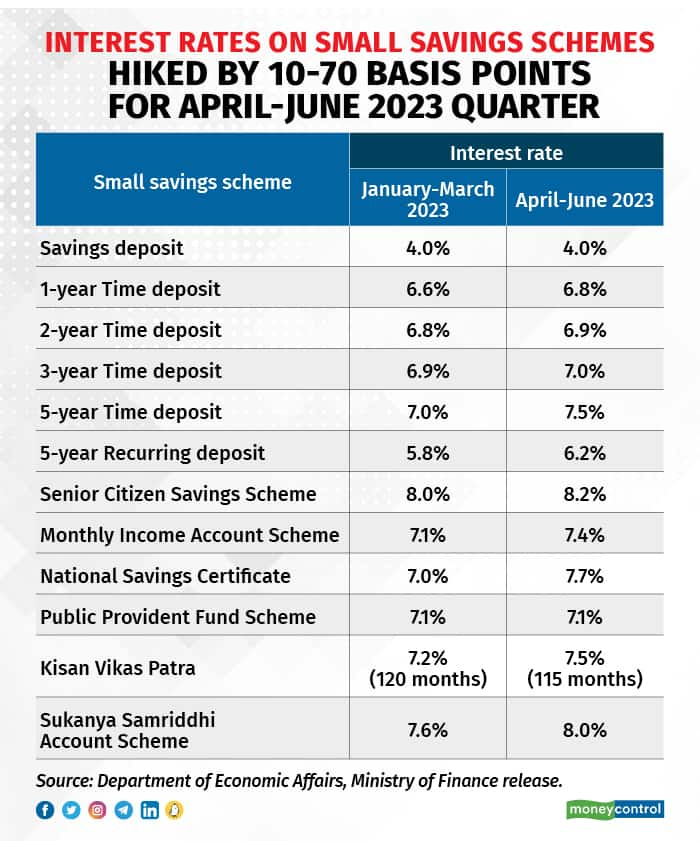RBI pauses, time to invest in debt funds
The Monetary policy committee (MPC) of the Reserve Bank of India (RBI) decided to leave the repo rate unchanged at 6.5 percent. This came as a surprise for a large pool of fixed income investors, as they were expecting a 25 basis points (bps) hike. Though only time will tell how the interest rate cycle unfolds in these uncertain times, fixed income investors should rejig their investments as the interest rate cycle may be turning.
Rate action
The MPC has already hiked the repo rate by 250 basis points since May 2022. This has led to an increase in bond yields and interest rates on fixed deposits, across maturities. Recently, the interest rates on small savings schemes too were hiked for the April to June 2023 quarter.

Though the RBI has decided to pause the rate hike cycle, the governor made it clear that, “Our job is not yet finished and the war against inflation has to continue till we see a durable decline in inflation closer to the target.”
Consumer price index-based inflation has gone up to 6.4 percent in February 2023 compared to 5.7 percent in December 2022. However, RBI expects the inflation will go down. “Assuming an average annual crude oil price (Indian basket) of $85 per barrel and a normal monsoon, CPI inflation is projected to moderate to 5.2 percent for 2023-2024,” the governor said.
Though the RBI has decided to continue with the ‘withdrawal of accommodation’ stance, industry experts do not see any material upward movement in bond yields hereafter.
Sandeep Bagla, CEO, Trust Mutual Fund, expects both GDP growth and inflation to be significantly below RBI’s year-end estimate of 6.5 percent and 5.2 percent, respectively. “Interest rates are likely to soften considerably from current levels. Bonds will perform well this year, generating capital gains over and above the coupon rates,” he says.
Suman Chowdhury, Chief Analytics Officer, Acuité Ratings & Research, says, “The pause in the rate cycle will be positive for the bond markets and government borrowings. Despite a higher issuance of government securities in H1FY24, we don’t expect 10 year G-Sec yields to move appreciably above the current levels. RBI will ensure that liquidity in the system remains either neutral or slightly in surplus.”
“The Reserve Bank of India surprised markets by holding policy rates, citing heightened uncertainty and comfort with the likely inflation trajectory in the coming months. We now see RBI on hold for the rest of FY2023-24, with only a major upwards inflation shock likely to stir back the bank into rate action,” wrote Rahul Bajoria, MD & Head of EM Asia (ex-China) Economics, Barclays in his note, ‘April MPC review: An early end of the hiking cycle.’
Put simply, the financial markets may be indicating the end of the rate hike cycle and bond yields may start coming down gradually, in line with inflation.
Impact on fixed income
The interest rates on various fixed income instruments are attractive at this moment. If the inflation goes down as envisaged, then the real rate of return becomes even more attractive. Real rate of return is computed by deducting the rate of inflation from the rate of interest payable on the bond.
The five-year National Savings Certificate offers a 7.7 percent rate of interest. The yield-to-maturity of portfolio of both short duration funds and medium-duration funds are at 7.8 percent, as on 28 February 2023, per data released by Value Research. The India 10-year benchmark bond yield came down to 7.2 percent post the policy announcement today, compared to 7.27 percent yesterday.
Despite the expectation that the interest rate hike cycle has ended, they are not going to come down in a hurry especially in times of uncertainty. If there is a spike in bond yields due to upward print in inflation or some other temporary reason, it can be a good opportunity to lock in your money. Investors get some time to lock in current yields, so there is no need to hurry.
What should you do?
Akshar Shah, Founder & CEO, Fixed, an online platform specialising in fixed income investments, advises investors to make the most of the elevated fixed deposit rates that banks and corporates are offering. “Current rates are attractive, between 7 percent and 9 percent, which can be locked in for the medium- to long-term,” he says.
Conservative investors keen on protection of capital and willing to lock in their money, should consider investments in small savings schemes.
Though the taxation of fixed deposit returns are now on par with the returns delivered by debt funds, there is a strong case for investing in debt funds if bond yields come down over the next one year. Debt funds with medium and long duration portfolios may see capital gains in such a scenario.
“Passive investments like fixed deposits will underperform debt funds,” says Bagla.
Though interest rates are expected to come down, it is not a certainty, and a sticky inflation may spoil the party. “Rising inflation erodes the value of fixed income securities over time and may lead to a decline in bond prices, negatively impacting long-duration funds,” says Rajat Dhar, Director, Investments, Indian Investors Federation. He recommends investments in short-duration debt funds. “A small allocation can be made to medium-duration funds as well,” he adds.
Even if you are contemplating investments in long-duration funds, stagger your investments and be prepared to hold for the long term.